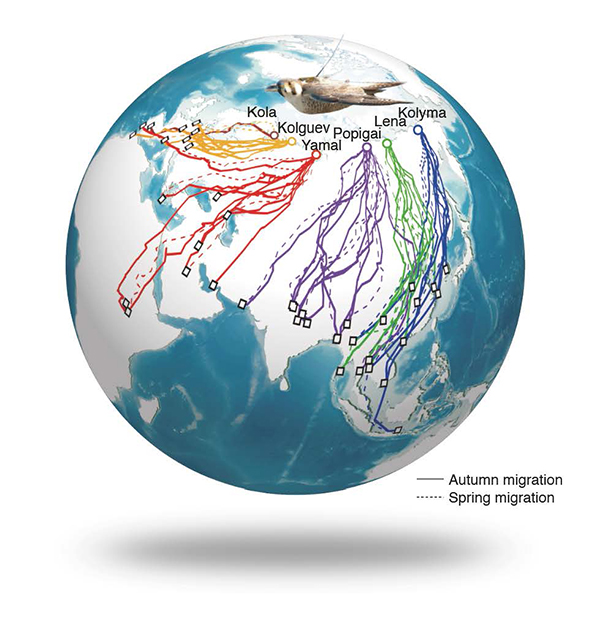a. Decode the spatiotemporal dynamics of bird migration routes and the genetics basis of long-distance migration
Satellite tracking data showed Arctic peregrines used five main migration routes across Eurasia, with high degree of migratory connectivity at both the population and individual levels, which was likely formed by longitudinal and latitudinal shifts in breeding grounds during the transition from the Last Glacial Maximum to the Holocene epoch. The gene ADCY8, which plays a role in long-term memory, is associated with this population-level difference in migratory distance. We further predict that future global warming may cause peregrines in western Eurasian Arctic to change migration strategies and face more risks of population decline.

Figure 1. The established migration system for peregrine falcons in Eurasian Arctic.

Figure 2. Past formation, present maintenance and future change of migration routes, and genetic basis for differences in migration distance.
b.Uncover the common underpinnings of independent degeneration events of flight ability and their evolutionary processes
We identified two convergent sites causing amino acid changes in ATGLSer321Gly and ACOT7Ala197Val in flight-degenerate birds. Functional assays suggest that Ser321Gly reduces lipid hydrolytic ability of ATGL, and Ala197Val enhances acyl-CoA hydrolytic activity of ACOT7. Our modeling simulations suggest a switch of main energy sources from lipids to carbohydrates in flight-degenerate birds. Our results thus suggest that physiological convergence plays an important role in flight degeneration, and anatomical convergence often invoked may not.

Figure 1. Identification of convergent evolutionary sites in flight-degenerate birds

Figure 2. Functional validation of ATGLAGT321GGT substitution.

Figure 3. Ancestral state reconstruction for ATGL321 and ACOT7197 codons.
